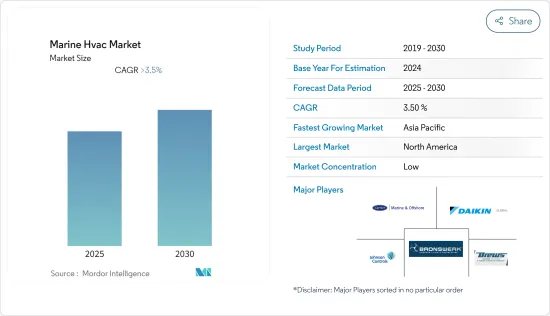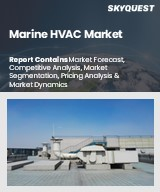
|
시장보고서
상품코드
1683212
선박용 HVAC : 시장 점유율 분석, 산업 동향 및 통계, 성장 예측(2025-2030년)Marine Hvac - Market Share Analysis, Industry Trends & Statistics, Growth Forecasts (2025 - 2030) |
||||||
선박용 HVAC 시장은 예측 기간 동안 3.5% 이상의 CAGR을 나타낼 것으로 예상됩니다.

주요 하이라이트
- 시장 역학은 조선업의 성과와 관련이 있으며, 조선업은 무역과 세계 경제의 성장에 의존하고 있습니다. 조선 산업은 세계 GDP 성장, 세계 해상 무역, 도시화 발전, 세계 철강 생산 증가에 의해 주도되고 있습니다. 해양 HVAC 시장에 영향을 미치는 중요한 트렌드 중 하나는 친환경 조선 기술입니다.
- 그러나 조선업의 확대는 경쟁 증가, 환경규제, 세계화의 진전, 정치-금융 불안 등의 영향을 받을 수 있습니다. 세계 선박 수는 5년 연속 성장세가 둔화되고 있으며, 이는 과잉 생산능력 때문인 것으로 분석됩니다.
- 선박용 공조기기 제조업체들은 에너지 절약과 비용 절감을 가능하게 하는 기술을 개발해 왔습니다. 주요 업체들은 빅데이터, 사물인터넷(loT) 등의 기술을 활용하여 에너지 절감을 실현하고 있습니다.
선박용 HVAC 시장 동향
여객선 부문은 예측 기간 동안 급성장할 것으로 예상됩니다.
여객선에는 유람선, 크루즈선, 오션라이너, 페리, 요트 등이 포함됩니다. 이들 선박의 선복량 점유율은 다른 선종에 비해 극히 미미하여 2018년 전체 선대 시장 가치의 11% 이상을 차지했습니다.
세계관광기구(UNTWO)에 따르면, 2018년에는 14억 명의 국제 관광객이 도착하여 2017년 대비 6% 증가하였습다. 유람선은 세계 레저 산업에서 가장 역동적이고 빠르게 성장하는 요소 중 하나이며, 목적지 경제와 지역사회에 큰 기여를 할 수 있습니다.
1990년 약 380만 명에 불과했던 여객 수는 2015년 2,220만 명을 넘어섰으며, 2019년 말에는 2,530만 명 이상의 승객이 유람선을 이용했습니다. 이는 1990년부터 2019년까지 연평균 6.55%의 승객 증가율에 해당합니다.
유람선 수요는 주로 북미에서 발생하며, 전 세계 크루즈 승객의 약 59%를 차지합니다. 승객의 객실의 편안함을 높이기 위해 모든 유람선에는 적절한 난방 및/또는 냉방 시스템이 장착되어 있습니다.
관광 및 여객 운송 증가에 따라 선박용 HVAC 시스템에 대한 수요는 예측 기간 동안 크게 증가할 것으로 예상됩니다.
선박용 HVAC 시장을 장악하고 있는 아태지역
아시아태평양 시장은 선박용 HVAC 시장을 독점하고 있습니다. 아시아태평양 중 인도가 가장 빠르게 성장하는 시장입니다.
인도의 해운산업은 국가 물류 인프라에 필수적인 요소이며, GDP의 14-15%를 차지하고 있습니다.
인도의 해안선은 7,517km에 달하며, 해안선을 따라 12개의 주요 항구와 150개 이상의 비주요 항구가 있습니다.
- 이들 12개 주요 항구는 주로 수출입(EXIM), 내항해운, 크루즈 해운을 담당하고 있습니다. 비주요 항만 중 내항해운을 취급하는 항구는 150개 항만 중 30-35%에 불과하며, EXIM 무역을 취급하는 항구는 이보다 훨씬 적습니다. 국내 해상화물 처리량과 관련하여 주요 항만은 2018년 4.77% 성장하여 6억 8,000만 톤을 기록했습니다.
국내 해운업계는 해외 무역량의 7-8%를 취급하고 있습니다. 상선대는 내항선과 외항선을 합쳐 1,400척입니다. 국내 선복량의 약 88%는 해외 무역용이며, 약 500척이 관여하고 있습니다.
유조선(원유 및 석유제품 운반선)은 전체 해외 선대의 28%인 1,500척을 차지합니다. 건화물선과 벌크선은 해외 선대의 28%를 차지하고 있습니다.
현재 KPCL의 해양 사업 그룹은 인도 해군의 선박에 HVAC 및 냉동 시스템을 공급하는 주요 공급업체입니다.
해양 HVAC 산업 개요
시장은 매우 세분화된 시장입니다. 시장을 독점하고 있는 주요 기업으로는 Carrier Corporation, Daikin Industries, Johnson Controls, Brownswerk Marine Inc. 등이 있습니다.
기타 혜택
- 엑셀 형식 시장 예측(ME) 시트
- 3개월간 애널리스트 지원
목차
제1장 서론
- 조사의 전제조건
- 조사 범위
제2장 조사 방법
제3장 주요 요약
제4장 시장 역학
- 시장 성장 촉진요인
- 시장 성장 억제요인
- Porter's Five Forces 분석
- 신규 진출업체의 위협
- 구매자 및 소비자의 교섭력
- 공급 기업의 교섭력
- 대체품의 위협
- 경쟁 기업간 경쟁 관계
제5장 시장 세분화
- 선박 유형별
- 여객선
- 화물선
- 어선
- 기타 선박 유형
- 기술 유형별
- 선박용 환기 시스템
- 선박용 공조 시스템
- 선박용 난방 시스템
- 선박용 냉동 시스템
- 용량별
- 20RT 미만
- 20-90RT
- 90RT 이상
- 용도별
- 엔진룸
- 화물실
- 데크
- 텐더 차고
- 기타
- 지역별
- 북미
- 미국
- 캐나다
- 기타 북미
- 유럽
- 독일
- 영국
- 프랑스
- 스페인
- 기타 유럽
- 아시아태평양
- 인도
- 중국
- 일본
- 기타 아시아태평양
- 라틴아메리카
- 멕시코
- 브라질
- 아르헨티나
- 중동 및 아프리카
- 아랍에미리트(UAE)
- 사우디아라비아
- 기타 중동 및 아프리카
- 북미
제6장 경쟁 구도
- 벤더의 시장 점유율
- 기업 개요
- Carrier Corporation
- Daikin Industries
- Bronswerk Marine Inc.
- Dometic Group
- Drews Marine GMBH
- Johnson Controls
- Frigomar
- Horn International AS
- GEA Farm Technologies
제7장 시장 기회와 향후 동향
LSH 25.03.27The Marine Hvac Market is expected to register a CAGR of greater than 3.5% during the forecast period.

Key Highlights
- The dynamics of the market studied are linked to the performance of the shipbuilding industry, which in turn, is dependent upon trade and global economic growth. The shipbuilding industry is being driven by the growth in the global GDP, global seaborne trade, rising urbanization, and an increase in global steel production. One of the significant trends impacting the marine HVAC market is green shipbuilding technology.
- However, the expansion of the shipbuilding industry can be affected by increasing competition, environmental regulations, enhanced globalization, and political and financial instability. For the fifth year in a row, world fleet growth has decelerated, owning to overcapacity.
- Marine HVAC manufacturers have been developing technologies to enable energy and cost-saving. Major companies have been relying on utilizing technologies, such as big data, loT, etc., to achieve energy efficiency.
Marine HVAC Market Trends
Passenger Vessels Segment is expected to grow with a Fast Pace during the Forecast Period
The passenger vessels include cruise ships, ocean liners, ferries, yachts, and other vessels. These vessel's share in dead-weight tonnage is negligible compared to that of other types of vessels, and thus accounted for more than 11% of the overall fleet's market value in 2018.
In 2018, 1.4 billion international tourist arrivals were recorded, according to the World Tourism Organization (UNTWO), a rise of 6% over 2017. Cruise shipping is one of the most dynamic and fastest-growing components of the leisure industry worldwide, and it can make a significant contribution to a destination's economy and local communities.
The demand for cruise ships is experiencing exponential growth, which grew from almost 3.8 million passengers in 1990 to more than 22.2 million in 2015. By the end of 2019, more than 25.3 million passengers are expected to travel on cruise ships. This adds up to an average annual passenger growth rate of 6.55% between 1990 and 2019.
The demand for cruise ships predominantly comes from North America, making up for almost 59% of the total number of cruise passengers across the world. To achieve more cabin comfort for the passenger, every cruise ship is equipped with a suitable heating and/or cooling system.
With the increase in tourism and passenger shipping, the demand for HVAC systems for marine applications is expected to grow significantly over the forecast period.
Asia-Pacific Dominating the Marine HVAC Market
The Asia-Pacific market is dominating the Marine HVAC market. Out of the Asia-Pacific region, India is the fastest-growing market.
The Indian maritime industry is an integral part of the country's logistics infrastructure and is accounted for 14-15% of the country's GDP.
The industry had gained significance due to the country's coastline of 7,517 km, with 12 major ports and over 150 non-major ports along the coastline.
- These 12 major ports majorly catered to export and import (EXIM), coastal shipping, and cruise shipping. Among the non-major ports, only 30-35% of the 150 ports catered to coastal shipping and a lot fewer catered to EXIM trade. In terms of the maritime cargo handled in the country, major ports registered a growth of 4.77% in 2018, at 680 million metric tons.
The domestic shipping industry handles 7-8% of the overseas trade by volume. The total merchant navy fleet includes coastal and overseas vessels that stood at ~ 1400. Around 88% of domestic capacity has been for overseas trade involving ~ 500 ships.
Oil tankers (crude and product) constituted 28% of the total overseas fleet, of 500 vessels. Dry cargo and bulk carriers accounted for another 28%, of the overseas fleet.
Currently, the Marine Business Group of KPCL is a major supplier of HVAC and refrigeration systems to vessels in the Indian Navy.
Marine HVAC Industry Overview
The Market is a highly fragmented market. Some of the major players dominating the market are Carrier Corporation, Daikin Industries, Johnson Controls, Brownswerk Marine Inc., and Drews Marine GmbH, amongst others.
Additional Benefits:
- The market estimate (ME) sheet in Excel format
- 3 months of analyst support
TABLE OF CONTENTS
1 INTRODUCTION
- 1.1 Study Assumptions
- 1.2 Scope of the Study
2 RESEARCH METHODOLOGY
3 EXECUTIVE SUMMARY
4 MARKET DYNAMICS
- 4.1 Market Drivers
- 4.2 Market Restraints
- 4.3 Porters 5 Force Analysis
- 4.3.1 Threat of New Entrants
- 4.3.2 Bargaining Power of Buyers/Consumers
- 4.3.3 Bargaining Power of Suppliers
- 4.3.4 Threat of Substitute Products
- 4.3.5 Intensity of Competitive Rivalry
5 MARKET SEGMENTATION
- 5.1 Vessel Type
- 5.1.1 Passenger Vessels
- 5.1.2 Cargo Carriers
- 5.1.3 Fishing Vessels
- 5.1.4 Other Vessel Type
- 5.2 Technology Type
- 5.2.1 Marine Ventilation Systems
- 5.2.2 Marine Air Conditioning
- 5.2.3 Marine Heating Systems
- 5.2.4 Marine Refrigeration Systems
- 5.3 Capacity
- 5.3.1 Less than 20 RT
- 5.3.2 20 - 90 RT
- 5.3.3 Above 90 RT
- 5.4 Application
- 5.4.1 Engine Room
- 5.4.2 Cargo Hold
- 5.4.3 Deck
- 5.4.4 Tender Garage
- 5.4.5 Other
- 5.5 Geography
- 5.5.1 North America
- 5.5.1.1 United States
- 5.5.1.2 Canada
- 5.5.1.3 Rest of North America
- 5.5.2 Europe
- 5.5.2.1 Germany
- 5.5.2.2 United Kingdom
- 5.5.2.3 France
- 5.5.2.4 Spain
- 5.5.2.5 Rest of Europe
- 5.5.3 Asia Pacific
- 5.5.3.1 India
- 5.5.3.2 China
- 5.5.3.3 Japan
- 5.5.3.4 Rest of Asia-Pacific
- 5.5.4 Latin America
- 5.5.4.1 Mexico
- 5.5.4.2 Brazil
- 5.5.4.3 Argentina
- 5.5.5 Middle-East and Africa
- 5.5.5.1 United Arab Emirates
- 5.5.5.2 Saudi Arabia
- 5.5.5.3 Rest of Middle-East and Africa
- 5.5.1 North America
6 COMPETITIVE LANDSCAPE
- 6.1 Vendor Market Share
- 6.2 Company Profiles
- 6.2.1 Carrier Corporation
- 6.2.2 Daikin Industries
- 6.2.3 Bronswerk Marine Inc.
- 6.2.4 Dometic Group
- 6.2.5 Drews Marine GMBH
- 6.2.6 Johnson Controls
- 6.2.7 Frigomar
- 6.2.8 Horn International AS
- 6.2.9 GEA Farm Technologies








